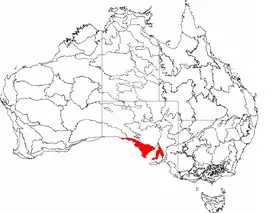Eyre Yorke Block
The Eyre Yorke Block, also known as the Eyre and Yorke mallee, is an interim Australian (IBRA) bioregion and a World Wildlife Fund ecoregion covering part of the Eyre Peninsula and all of Yorke Peninsula as well as land to its immediate east in South Australia.[2][3][4] [5] [6] [7]
| Eyre Yorke Block Eyre and Yorke mallee | |
|---|---|
 Kangaroos at Innes National Park on the Yorke Peninsula | |
 Map of the Eyre Yorke Block, a.k.a. Eyre and Yorke mallee | |
| Ecology | |
| Realm | Australasian |
| Biome | Mediterranean forests, woodlands, and scrub |
| Borders | |
| Geography | |
| Area | 60,195 km2 (23,241 sq mi) |
| Country | Australia |
| States | South Australia |
| Conservation | |
| Conservation status | Critical/endangered |
| Protected | 8,816 km² (15%)[1] |
Location and description
These peninsulas consist of hilly country originally covered in eucalyptus woodland. However this is good soil for farming and the woodland has mostly been cleared for agriculture now. This coast has a temperate climate with a wet winter (300mm to 600mm of rainfall per year).
Subregions
The IBRA identifies five subregions of the bioregion:
- Southern Yorke – 438,470 hectares (1,083,500 acres)
- St Vincent – 1,093,789 hectares (2,702,810 acres)
- Eyre Hills – 1,172,576 hectares (2,897,500 acres)
- Talia – 1,096,175 hectares (2,708,710 acres)
- Eyre Mallee – 2,319,398 hectares (5,731,360 acres)
Flora
The original vegetation of these low hills was woodland of short trees with a shrubby undergrowth. The original woodland consisted mainly of a tea tree Melaleuca lanceolata and mallee box (Eucalyptus porosa), a mallee eucalyptus. The flora of the two peninsulas does differ, with the Eyre Peninsula flora having similarities with areas further west as well as number of endemic species, while the Yorke Peninsula has plants typical of areas to the east.
Fauna
Mammals of the region include the western grey kangaroo and the southern hairy-nosed wombat, although many more (such as the tammar wallaby have become extinct on the two peninsulas since they have been cleared for farmland. Birds include the emu.
Threats and preservation
Most of the area has been cleared for farmland resulting in reduced populations and local extinction of much wildlife, especially on Yorke Peninsula. However clearance has mostly ceased now and the northern areas of Eyre Peninsula in particular still have large areas of mallee woodland while the coastal dunes remain mostly unspoilt also. Weeds, fertiliser and herbicide runoff are still threatening habitats. Protected areas include Innes National Park on Yorke Peninsula.
Protected areas
15.24% of the ecoregion is in protected areas. They include:[6]
- Adelaide International Bird Sanctuary National Park—Winaityinaityi Pangkara
- Buckleboo Conservation Reserve
- Coffin Bay National Park
- Cortlinye Conservation Reserve
- Cunyarie Conservation Reserve
- Gawler Ranges National Park
- Hambidge Wilderness Protection Area
- Hincks Wilderness Protection Area
- Innes National Park
- Lacroma Conservation Reserve
- Lincoln National Park
- Memory Cove Wilderness Protection Area
- Moongi Conservation Reserve
- Mootra Conservation Reserve
- Mount Remarkable National Park
- Pinkawillinie Reservoir Conservation Reserve
- Poolgarra Conservation Reserve
- Tola Conservation Reserve
- Wardang Island Indigenous Protected Area
- Yalata Indigenous Protected Area
References
- Dinerstein, Eric; Olson, David; et al. (June 2017). "An Ecoregion-Based Approach to Protecting Half the Terrestrial Realm". BioScience. 67 (6): 534–545. doi:10.1093/biosci/bix014. PMC 5451287. PMID 28608869.
{{cite journal}}: CS1 maint: date and year (link) Supplemental material 2 table S1b. - Environment Australia. "Revision of the Interim Biogeographic Regionalisation for Australia (IBRA) and Development of Version 5.1 - Summary Report". Department of the Environment and Water Resources, Australian Government. Archived from the original on 5 September 2006. Retrieved 31 January 2007.
- IBRA Version 6.1 Archived September 8, 2006, at the Wayback Machine data
- "Eyre and York mallee". Terrestrial Ecoregions. World Wildlife Fund.
- "Map of Ecoregions 2017". Resolve. Retrieved 20 August 2021.
- "Eyre and York mallee". Digital Observatory for Protected Areas. Retrieved 12 May 2022.
- "Eyre and York mallee". The Encyclopedia of Earth. Retrieved 20 August 2021.
Further reading
- Thackway, R and I D Cresswell (1995) An interim biogeographic regionalisation for Australia : a framework for setting priorities in the National Reserves System Cooperative Program Version 4.0 Canberra : Australian Nature Conservation Agency, Reserve Systems Unit, 1995. ISBN 0-642-21371-2